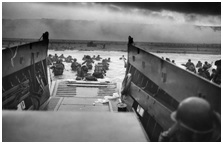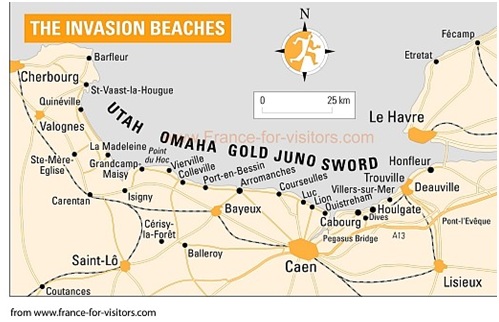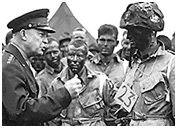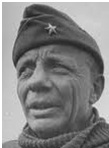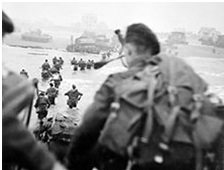|
 |
|
 |
D-Day - Leadership and Strategy
D-Day (1944)
Famous for...
1. The Allied invasion in World War Two The biggest sea invasion in history against Nazi Germany (code named Overlord). American (pictured below), British and Canadian troops landed on the Normandy beaches in northern France on 6th June 1944.
2. Saving Private Ryan (Steven Spielberg’s film) Its opening sequence on Omaha beach (one of the American invasion beaches – see below) shows how frightening D-Day was.
What was the invasion force?
Which beaches were attacked?
The landing beaches were from west to east (see map above):
1. Utah (American troops).
2. Omaha (American) - the bloodiest beach.
3. Gold (British).
4. Juno (Canadian).
5. Sword (British, helped by French commandos).
Key people American chief of the Allied forces - pictured right talking to troops just before D-Day. Known as Ike.
British chief of the Allied invasion army (pictured right) . Known as Monty.
Omar Bradley Head of the American army (pictured right) .
Bertram Ramsay British head of the Allied navy (pictured right) .
Trafford Leigh-Mallory British head of the Allied air force(pictured right).
German leader.
Erwin Rommel and Gerd von Runstedt German army chiefs in Normandy.
Key events before D-Day
22 June 1941 Germans invade Russia.
7 December 1941 The Japanese attack Pearl Harbour America declares war on Japan and Germany.
1942 onwards 2½ million American soldiers move into Britain Famously described by the British as: “Overpaid, oversexed and over here”.
2 February 1943 The Russians defeat the Germans at Stalingrad, a major turning point of the war. The Battle of Stalingrad began in August 1942 and thousands were killed:
May 1943 The Battle of the Atlantic ends. So German submarines (U-boats):
August 1943 Operation Crossbow begins. This bombed and seriously disrupted the development and launching of Germany’s deadly V-1 and V-2 unmanned missiles which would have seriously threatened D-Day.
What was it like to be a D-Day Allied soldier?
1. Fear Particularly amongst the majority of troops who were conscripted civilians and facing their first battle, there
was a fear of:
Many were comforted by religion and music stars like the:
Vera Lynn's songs We’ll Meet Again and The White Cliffs of Dover were great morale boosters.
2. Sickness Bad weather delayed D-Day by a day, causing:
3. Weighed down Most soldiers were hampered by:
4. Camaraderie Courage came from a desire not to let their colleagues down.
5. Common purpose Everyone hated Hitler (pictured right) and the Nazis.
6. Relief After many months of arduous training, the troops wanted to get on with the job.
7. Sadness Faced with death, many soldiers wrote farewell letters to their families and loved ones.
Some D-Day heroes
Dick Winters (American) 1918-2011 (pictured right) A paratrooper who successfully led his men in the capture of four German artillery guns that were firing on the invasion at Utah beach. He was a leader of:
a) character and humility (to earn his men’s respect).
b) competence (based on learning from experience).
c) courage (leading from the front with bold persistence).
He was the subject of the book and TV mini-series, Band of Brothers.
Theodore Roosevelt Jr. (American) 1887-1944 (pictured right) Son of the former president, Theodore Roosevelt, At Utah beach he wisely went straight inland rather than returning to the originally planned landing point (the tide had drifted the Americans a mile south). “We’ll start the war from right here!”, he famously said. Despite arthritis from his World War One injuries, he:
He died of a heart attack only a month later. He was played by Henry Fonda (pictured right) in the 1962 D-Day film, The Longest Day.
Den Brotheridge (British)
1915-44 (pictured right) The first Allied soldier killed on D-Day One of the paratroopers (led by John Howard) dropped near the Sword beach before the invasion fleet arrived. They captured the strategically important Pegasus Bridge that crossed the River Orne, north of the vital town of Caen. Denis Edwards, one of Brotheridge's men, said he had the greatest respect for him, because: “He had never asked us to do anything that he would not do himself”. Tragically Brotheridge's wife was expecting a baby.
Lord Lovat (British) 1911-95 The calm and courageous British commando chief who asked his personal piper, Bill Millin. to play a morale boosting Scottish tune on landing at Sword beach (pictured below - Lovat is in the water on the right).
Lovat and his men then went to help John Howard’s paratroopers. Lovat was seriously wounded on 12th June and sent home. He died heartbroken, shortly after his tax bills forced him to sell his family’s castle in Inverness, Scotland, to Ann Gloag, the co-founder of the bus company, Stagecoach.
Stanley Hollis (British) 1912-72 (pictured right) D-Day’s only VC after landing on Gold beach. Hollis heroically:
Why was D-Day successful?
1. Weather forecasting British RAF officer, James Stagg (pictured right), forecasted correctly that the weather of 6th June would be all right, despite unsettled weather that had caused a day’s postponement of D-Day. The Germans were convinced that the invasion wouldn’t occur during the bad weather and so were
unprepared. Their army chief, Erwin Rommel (pictured right) was in Berlin on 6th June visiting his wife and Hitler.
2. Almighty America and Red Russia America’s industrial might was crucial. By the end of 1943 it was producing 8,000 planes a month. The Russian eastern offensive also diverted at least two thirds of the German army away from the defence of the French coast.
3. Numerical superiority The Allies outnumbered the Germans on land and sea and in the air (with 10,000 planes against only 300). Allied bombers ensured that no U-Boats (German submarines) got into the Channel. This numerical superiority was just as well because of the problems the Allies faced on D-Day and the following weeks:
a) strong resistance (particularly from the SS divisions) The Germans:
b) bad weather A bad storm on 19-22 June:
c) tall and thick hedgerows (bocage in French) These:
d) superior German weaponry Particularly good were the:
4. Leadership The Allied commander, Dwight D. Eisenhower, was a great:
Crucially he also forced American and British air force chiefs to give him control and the full support of Allied bombers. But Hitler’s constant interference and ‘divide and rule’ policy led to conflicts in the German leadership For example, the Germans had two leaders in Normandy:
5. Creativity The American, Andrew Higgins, designed the American landing vessel, the LCVP (called Higgins boats, pictured right). The British built:
These Funnies were specially designed tanks for different jobs like:
6. Deception The invasion was a complete surprise. The Germans were convinced that the invasion would occur in the Pas-de-Calais because of Operation Fortitude, the Allies' deception strategy. This included: a) the army that wasn't The American General George Patton’s (pictured right) fictitious army (with dummy planes and military equipment) in the south east of England.
b) false information This came from German double agents in Britain (like the Spaniard, Joan Pujol Garcia, known as Garbo, pictured right).
c) Monty's double An actor was used to impersonate the British general, Bernard Montgomery in Gibraltar to give the impression of an invasion in southern Europe.
7. Sabotage and intelligence The French Resistance destroyed roads, railways and telephone/telegraph lines helped by:
a) Allied bombers
b) British secret agents (in the Special Operations Executive ,SOE) These included Violet Szabo (1921-45), pictured right, who was parachuted into France the day after D-Day, captured, tortured and executed. Her bravery was portrayed in the 1958 film, Carve Your Name With Pride.
Crucial information about the Normandy beaches was provided by:
This deciphering:
8. Troops The Allied troops:
9. The Atlantic Wall This defence against possible invasion was built by the Germans from 1942 onwards along the Dutch and French
coastline. But its great length made it impossible to defend well everywhere. The famous Dam Busters raid (with bouncing bombs designed by Barnes Wallis, pictured right) destroyed two vital German dams. Workers were diverted away from the Atlantic Wall to repair them.
10. Learning The disastrous airborne Dieppe Raid in 1942 showed the importance of:
Results of D-Day
1.Casualties Around 10,000 Allied casualties (killed or wounded) 4,000 to 9,000 German (exact number unknown).
2. Second front The D-Day invasion attacked the Germans in the west to support the Russian eastern offensive. Russian deaths (military and civilian) in World War Two (27 million) were far higher than anybody else's:
3. Freedom D-Day:
The countries in Eastern Europe that Russia invaded became part of its empire.
4.Victory D-Day:
Key events after D-Day
7 June 1944 Americans capture Cherbourg.
10 July 1944 British capture northern Caen after a long, bloody battle.
25 July 1944 Americans break through German defences in Operation Cobra.
26 - 30 July 1944 British fail to break German defences in Operation Epsom.
25 August 1944 Paris liberated.
10 September 1944 Americans enter Germany.
30 April 1945 Hitler commits suicide, a day after the Russians capture Berlin.
8 May 1945 VE (Victory in Europe) Day after Germany surrenders.
Key quotes
D-Day will live with me till the day I die...It was the longest, most horrible day that I or anyone else went through. - Felix Branham, American soldier.
I think I had experienced first-hand what being ‘scared shitless’ really meant. - Harry Parley, British army.
The only people on this beach are the dead and those that are going to die – now let’s get the hell out of here, - George Taylor, American commander on Omaha beach (pictured right).
Every man was a hero. - Cecil Breeden, American soldier at Omaha beach.
There were bodies - dead bodies, living bodies. All the blood in the water made it look as though men were drowning in their own blood. - William Spearman, British army.
I have full confidence in your courage, devotion to duty and skill in battle. We will accept nothing less than total victory! Good luck! - Dwight D. Eisenhower’s message to the Allied troops just before D-Day.
The first twenty four hours of the invasion will be decisive...for the Allies, as well as Germany, it will be the longest day. - Erwin Rommel.
On an average, in a platoon of twenty-five, five will do their best to fight...and fifteen will follow. The rest will be useless. This applies to the whole infantry corps. - British army officer.
The end of the war took away the purpose that for years had united young men of a dozen different countries in friendship and mutual loyalty. - Frank Ziegler, RAF pilot.
Best books Max Hastings, Overlord (1984) and his single volume history of World War Two, All Hell Let Loose (2011). Anthony Beevor's D-Day (2009) is also excellent.
Films on D-Day
|
|
|
||
|
|
|
||
|
||
| Copyright © wisdomtowin.com All Rights Reserved | ||
|

